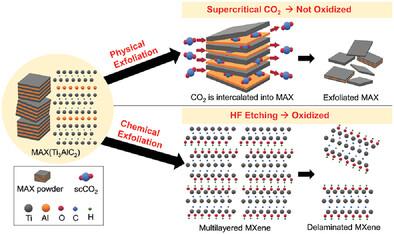当前位置:
X-MOL 学术
›
Adv. Mater. Technol.
›
论文详情
Our official English website, www.x-mol.net, welcomes your
feedback! (Note: you will need to create a separate account there.)
Supercritical CO2-Assisted Layer Exfoliation of MAX Ti3AlC2 Nanosheets Without Etching
Advanced Materials Technologies ( IF 6.4 ) Pub Date : 2024-03-12 , DOI: 10.1002/admt.202301437 Hyeri Kim 1 , Dajeong Gwon 2 , Dohyeong Kim 2 , Jinho Kee 2 , Jaseung Koo 1, 2
Advanced Materials Technologies ( IF 6.4 ) Pub Date : 2024-03-12 , DOI: 10.1002/admt.202301437 Hyeri Kim 1 , Dajeong Gwon 2 , Dohyeong Kim 2 , Jinho Kee 2 , Jaseung Koo 1, 2
Affiliation

|
Although MAX exhibits excellent heat resistance, chemical resistance, and electrical conductivity due to its metallic and ceramic properties, the exfoliation of the MAX sheets with oxidation stability is a key issue in maximizing its advantages and improving its performance. In this study, the supercritical CO2 (scCO2) technique is employed to mechanically exfoliate MAX sheets without chemical etching. The supercritical fluid process is conducted in two continuous steps under different CO2 conditions: supercritical drying and rapid exfoliation of the supercritical suspension (RESS). X-ray diffraction and scanning electron microscopy results reveal that both supercritical drying (45 °C and 100 bar) and RESS (100 °C and 120 bar) processes are required for MAX sheet exfoliation. During these processes, scCO2 molecules are deeply intercalated into the MAX sheet interlayers. The scCO2-treated MAX sheets and oxidized MXene exhibit electrical conductivities of 457, 303, and 46 S cm−1 at 100 bar based on the powder resistivity measurement system. Because the layer exfoliation of MAX sheets is closely correlated with the performance of MAX-based materials, the technique employed in this study can provide a route for applications requiring expanded MAX, ranging from nanoelectronic devices to energy-storage materials such as supercapacitors and battery anodes.
中文翻译:

超临界 CO2 辅助层剥离 MAX Ti3AlC2 纳米片无需蚀刻
尽管MAX因其金属和陶瓷特性而表现出优异的耐热性、耐化学性和导电性,但具有氧化稳定性的MAX片材的剥离是最大限度地发挥其优势并提高其性能的关键问题。在本研究中,采用超临界CO 2 (scCO 2 ) 技术在不进行化学蚀刻的情况下机械剥离MAX 片材。超临界流体过程在不同的CO 2条件下分两个连续步骤进行:超临界干燥和超临界悬浮液的快速剥离(RESS)。 X 射线衍射和扫描电子显微镜结果表明,MAX 片材剥离需要超临界干燥(45 °C 和 100 bar)和 RESS(100 °C 和 120 bar)工艺。在这些过程中,scCO 2分子深深地嵌入到MAX片夹层中。根据粉末电阻率测量系统,经scCO 2处理的MAX片和氧化MXene在100巴下表现出457、303和46 S cm -1的电导率。由于 MAX 片材的层剥离与 MAX 基材料的性能密切相关,因此本研究中采用的技术可以为需要扩展 MAX 的应用提供途径,从纳米电子器件到超级电容器和电池阳极等储能材料。
更新日期:2024-03-12
中文翻译:

超临界 CO2 辅助层剥离 MAX Ti3AlC2 纳米片无需蚀刻
尽管MAX因其金属和陶瓷特性而表现出优异的耐热性、耐化学性和导电性,但具有氧化稳定性的MAX片材的剥离是最大限度地发挥其优势并提高其性能的关键问题。在本研究中,采用超临界CO 2 (scCO 2 ) 技术在不进行化学蚀刻的情况下机械剥离MAX 片材。超临界流体过程在不同的CO 2条件下分两个连续步骤进行:超临界干燥和超临界悬浮液的快速剥离(RESS)。 X 射线衍射和扫描电子显微镜结果表明,MAX 片材剥离需要超临界干燥(45 °C 和 100 bar)和 RESS(100 °C 和 120 bar)工艺。在这些过程中,scCO 2分子深深地嵌入到MAX片夹层中。根据粉末电阻率测量系统,经scCO 2处理的MAX片和氧化MXene在100巴下表现出457、303和46 S cm -1的电导率。由于 MAX 片材的层剥离与 MAX 基材料的性能密切相关,因此本研究中采用的技术可以为需要扩展 MAX 的应用提供途径,从纳米电子器件到超级电容器和电池阳极等储能材料。











































 京公网安备 11010802027423号
京公网安备 11010802027423号